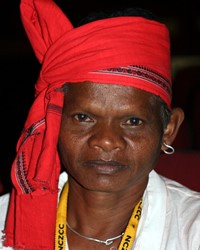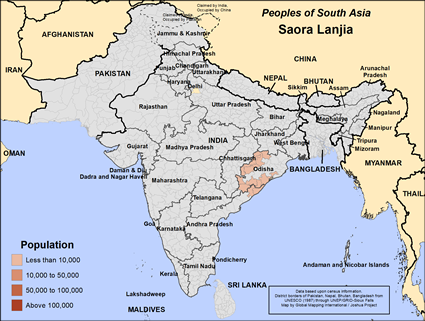Saora Lanjia in India

Photo Source:
Ramesh Lalwani - Flickr
Creative Commons
|

Map Source:
People Group data: Omid. Map geography: UNESCO / GMI. Map Design: Joshua Project
|
| People Name: | Saora Lanjia |
| Country: | India |
| 10/40 Window: | Yes |
| Population: | 25,000 |
| World Population: | 25,000 |
| Primary Language: | Odia |
| Primary Religion: | Hinduism |
| Christian Adherents: | 28.61 % |
| Evangelicals: | 0.00 % |
| Scripture: | Complete Bible |
| Ministry Resources: | Yes |
| Jesus Film: | Yes |
| Audio Recordings: | Yes |
| People Cluster: | South Asia Tribal - other |
| Affinity Bloc: | South Asian Peoples |
| Progress Level: |
|
Introduction / History
The Saoras are one of India's most ancient tribes. Most live in Odisha. Odia, the language of Odisha, has replaced the Sora language. There are many Saora subgroups, including the Lanjias, who are defined by living in the plains.
What Are Their Lives Like?
Saora families are clan-based with strong kinship ties. Their homes are simple and functional, usually made of mud or stone.
Though slash-and-burn agriculture is still the lifestyle of most Saora families, they are increasingly moving to urban settings for better opportunities working for the government. Those who remain on the farm are adopting better agricultural methods leading to a higher yield.
Their local political system is led by village elders who make up a village council.
Saora art involves geometric designs and symbolic art used for rituals.
What Are Their Beliefs?
Animism plays a large part in their spiritual practices, though roughly two-thirds are Hindu and one-third are Christian.
What Are Their Needs?
Their agricultural economy is eroding as deforestation increases. Many are losing their ancestral lands. For that reason, Lanjia Saoras need to adapt to urban jobs. Young Saoras are trying to get the education they need to get high-paying jobs.
Prayer Points
Pray for revival in Lanjia Saora villages and churches.
Pray that soon, Lanjia Saora disciples will make disciples of Tibetan Buddhists.
Pray for them to understand that only the Lord Almighty can provide for their physical and spiritual needs.
Pray for hundreds to share Christ locally and internationally.